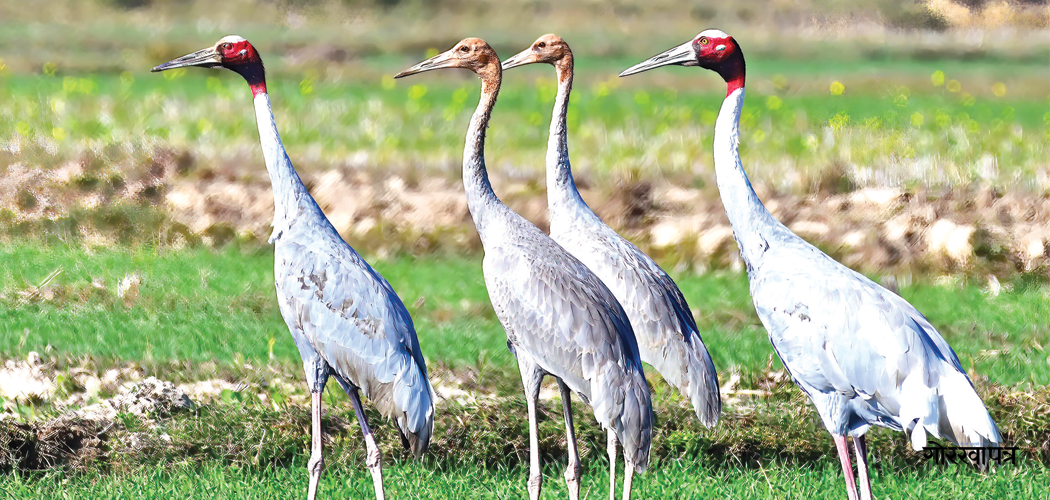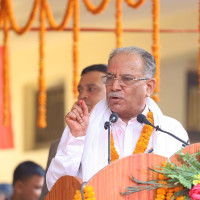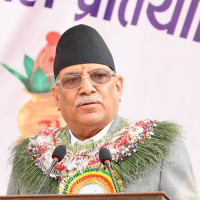- Sunday, 5 May 2024
Sarus Crane: The Largest Flying Bird
The world's tallest flying bird is the Sarus Crane (Grus Antigone). This bird can grow up to 61.4 inches in height. There are 15 species of this bird in the world, of which 4 species are found in Nepal- Common Crane (Laxman Sarus), Demoiselle Crane (Karyankurung), Black Naked Crane (Karikanths Sarus) and Sarus Crane (Sarus).
According to reports, 85 per cent of the stork crane population in Nepal is found in Kapilvastu and Rupandehi districts. In Rupandehi, especially on the way to Parasi from Belihiya road area, Bethari area, it is highly visible. Around Jagdishpur wetland area of Kapilvastu district, Gotihawa area, Kudan area, Niglihawa area etc. It can also be seen in the western and central Terai regions of Nepal. Birds of this species are largely non-migratory. However, some stork populations move a short distance.
In Terai Areas
I went to different areas of Kapilvastu, Rupandehi and Nawalparasi five times to capture the image of this bird and found most of them in Kapilvastu and Rupandehi areas. According to ornithologists, storks have been recorded in Kapilvastu, Rupandehi, Chitwan, Nawalparasi, Dang, Banke, Bardiya, Kailali and Kanchanpur.
According to Paras Yadav, a local of Rupandehi Bethari, this bird used to be seen here a lot. But now it is very low. Due to a lack of public awareness, this bird used to be killed, but for the past few years, no one cared about it and said that it should not be killed. The stork is found in South and Southeast Asian countries like Nepal, India, Bangladesh, Cambodia, Malaysia, Vietnam and Thailand. The number of these birds in the world is estimated at 3000 to 5000 and in Nepal, it is estimated at 450 to 700.
Storks prefer to live on arable land, near ponds, and around wetlands. It also makes the baby grow in the paddy field. This bird eats mainly plants, grains, sprouts, grasses, frogs, fish, lizards, large insects etc. found in wetland areas.
This stork breeds throughout the year. On the ground, it makes its nest about two metres in diameter. It lays 1 to 3 eggs at most. After laying eggs, males and females protect them alternately. The chicks hatch at an interval of about 30 to 32 days, and the babies roam with the mother for 5 to 6 months.

The age of this bird has been recorded in the zoo for 40 years. It is a kind of native bird. It does not move. As the bird perishes in the world, it lays its eggs in the ground. Therefore, mongooses, small foxes, foxes, etc. are the food of predators, while egg theft, collection of chickens and poachers are the major challenges for stork conservation.
IUCN has placed this stork on the Red List of Sensitive Birds. This bird is also included in Schedule 1 as per the CITES Agreement. According to Nepal's National Parks and Wildlife Conservation Act 2029 BS, this bird is protected.
Couples are believed to live for life, and if someone kills or harms their spouse, they may even starve to death. In some parts of India, it is customary to show a pair of birds to a newlywed couple after marriage. The stork crane is considered a sacred bird and is also traditionally harmless. This bird is also worshipped in India. Legend has it that the poet Balmiki also cursed a hunter who killed a stork crane and was then inspired to write the epic Ramayana. In ancient Hindu scriptures, the meat of storks was considered taboo.
This is an amazing bird. When a bird is killed, its surviving companion comes to the spot where another was killed for several days, and the is traditionally believed to starve to death.
The study of this bird's experts increased significantly only after 1990, but the study was limited to Rupandehi and Kapilvastu districts. About two dozen stork studies have been found since 1990. But most of them were unpublished reports and theses by university students. This stork crane has become a symbol of an ancient culture that values all aspects of life and its deep connection.
These birds live in pairs. Don't be separated from your partner even for a moment. To a viewer, it seems like pure faith and dedication. This bird is also considered a symbol of love.
Attracted To Farmland
According to Mohan Bikram Shrestha, Research Officer of Bird Conservation Nepal, there are an estimated 400 to 700 different species of storks in Nepal. Farmland is the main reason for the sighting of 85 per cent of stork crane species in the Kapilvastu and Rupandehi districts. In these districts, paddy farming and wheat farming are rampant which makes it easy for the stork crane birds to nest and easy for the birds to graze.
Similarly, according to Mr Lalit Gurung, Chairman of Jagdishpur Reservoir Multi-stakeholder Forum of Jagdishpur Lake, a famous wetland area of Kapilvastu district, various species of stork cranes were seen in this area earlier. Since its decline, we have been carrying out public awareness activities for the past few years for this bird's conservation in the surrounding villages, hamlets and houses.
It is very important to spread public awareness about such birds in Nepal to protect them.
(Dhungana is a former chief photo editor of Gorkhapatra and is a wildlife photographer. All photos by the writer)






-original-thumb.jpg)



